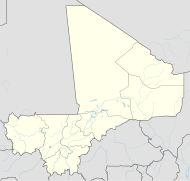Mali Military Power Ranking 2025
MPR Rank: 125th
MPR SCORE: 243
MPR Index: 0.0663 (1.0000 is perfect)
Reverse MPR Index: 0.8849 (0.0000 is perfect)
Z Score: -0.545 (standard deviations above the mean)
Overview
Mali ranks 125th globally in the 2025 Military Power Rankings. Its armed forces, the Malian Armed Forces (Forces Armées Maliennes – FAMa), are at the forefront of the fight against jihadist insurgencies in the Sahel region, particularly in northern and central Mali. The FAMa’s primary mission is internal security, territorial integrity, and counterterrorism operations. However, the military continues to face major challenges due to political instability, including multiple coups since 2020, and a lack of sufficient logistical capacity, airpower, and modernization.
Mali’s strategic position in West Africa and its status as an epicenter of regional jihadist activity make it a critical actor in Sahel security. The country has transitioned from relying primarily on France (Operation Barkhane) and UN peacekeepers (MINUSMA) to developing new partnerships, most notably with Russia, including the reported presence of Wagner Group personnel. The FAMa remains focused on securing key roadways, border zones, and government-held towns, with mixed success.
Strengths
1. Real Combat Experience in Asymmetric Warfare
FAMa is engaged in daily combat with ISIS-Greater Sahara (ISGS), Jama'at Nasr al-Islam wal Muslimin (JNIM), and Al-Qaeda affiliates, gaining substantial operational experience in ambush tactics, IED clearance, and desert warfare.
2. Russian Security Assistance and Emerging Partnerships
Following the French withdrawal, Mali has deepened security ties with Russia, acquiring new military hardware, aircraft, and combat advisors, which have helped bolster urban defense and quick reaction capabilities.
3. Central Role in Sahel Counterinsurgency Operations
Mali serves as the geographic and strategic core of the Sahel counterterror theater, with FAMa operations linked to border security missions with Burkina Faso, Niger, Mauritania, and Algeria, creating multilateral coordination channels.
Why Mali Is Ranked 125th
1. Inadequate Equipment and Force Structure
FAMa lacks sufficient modern armor, rotary-wing assets, ISR platforms, and sustainment capacity, operating with a mix of Soviet-era vehicles, light transport aircraft, and donated equipment prone to maintenance issues.
2. Institutional Instability and Command Fragmentation
Repeated military coups (2020, 2021) and the dissolution of civilian governance structures have eroded cohesive command, delayed reforms, and undermined long-term force professionalization.
3. Reliance on External Support and Foreign Advisors
Despite shifting partnerships, Mali remains heavily dependent on foreign trainers, external funding, and foreign combat support to execute complex operations. Independent offensive action is limited to localized areas.
Conclusion
Mali’s military is a high-tempo, combat-engaged force with frontline counterinsurgency responsibilities, but lacks the structure, modern systems, and command resilience necessary for strategic autonomy. Though its global ranking is low, Mali remains pivotal in the Sahel’s security equation, with operational relevance outpacing its formal capabilities. As international alliances shift, Mali’s ability to build a self-reliant force will determine its future role in regional defense.
Military Strength and Force Projection
Active Military Personnel: 25,000 (IISS 2023)
Reserve Personnel: 10,000 (CIA World Factbook)
Paramilitary Forces: 8,000 (Gendarmerie and National Guard)
Army Personnel: 20,000
Navy Personnel: None (landlocked)
Air Force Personnel: 5,000
Ground Forces
Main Battle Tanks (MBTs): 50+ (older Soviet models, T-54/T-55)
Armored Fighting Vehicles (AFVs): 200+
Artillery (Towed and Self-Propelled): 100+
Air Force
Combat Aircraft: 10+ (SIPRI 2023)
Helicopters: 15+
Transport Aircraft: 5+
Aircraft Breakdown:
MiG-21: 5 (older aircraft, limited capability)
Mi-8 Helicopters: 10 (transport helicopters)
Naval Forces
As a landlocked nation, Mali does not have a navy and has no significant maritime capabilities. Its military efforts are focused on land and air operations, particularly in combating insurgencies and securing its borders.
Missile Capabilities
Mali’s military does not possess advanced missile systems. Its military efforts are geared toward conventional counter-insurgency operations, and it lacks any significant missile capability or air defense systems.
Strategic Partnerships
Mali has traditionally received military assistance from France and other international partners. However, in recent years, there has been a shift toward closer cooperation with Russia, which has supplied military equipment and advisors. Mali also benefits from UN peacekeeping forces operating in the country (MINUSMA). Despite this, the country faces significant challenges in maintaining control over its territory, especially in the face of growing insurgencies.
Military History & Combat Experience
Mali’s military history is shaped by colonial legacy, territorial conflicts, and the ongoing multi-front insurgency, giving FAMa a complex and intense combat background within the African security context.
Tuareg Rebellions (1990, 2006, 2012):
Mali has faced repeated Tuareg uprisings in the north, including the major 2012 rebellion that resulted in the loss of northern territory to separatist groups and jihadist coalitions. These conflicts forced FAMa into guerrilla warfare, urban defense, and long-range patrols across the Sahara-Sahel region.2012 Coup and Military Collapse:
A coup triggered by frustration with the northern insurgency led to the partial disintegration of the army, followed by the occupation of Timbuktu, Gao, and Kidal by jihadist groups, until French forces intervened in 2013 under Operation Serval.Operation Barkhane and MINUSMA (2013–2022):
Mali became the focal point of French counterterrorism and UN peacekeeping efforts, with FAMa working alongside foreign troops in efforts to secure towns, escort convoys, and rebuild territorial control—often with limited success.Russian Military Cooperation and Post-Barkhane Realignment (2022–present):
After the exit of French and European forces, Mali signed military agreements with Russia, receiving combat helicopters, trainers, and airstrikes in support of ground troops, shifting the balance of its operational alliances and tactics.Joint Border Security Operations with Neighbors:
Mali has coordinated cross-border missions with Burkina Faso and Niger, particularly in the Liptako-Gourma triangle, targeting transnational jihadist movements and attempting to create a regional security buffer amid rising instability.
Mali’s military legacy is one of persistent conflict, external reliance, and adaptive field engagement. While far from a conventional fighting force, the FAMa plays an indispensable role in Sahel security, fighting one of Africa’s most entrenched insurgencies under severe resource constraints.
General Information
Demographics and Geography
Population: ~22.5 million (2024 est.)
Population Available for Military Service: ~7.6 million
Geographic Area: 1,240,192 km²
Land Boundaries: 7,243 km
Bordering Countries: Algeria, Burkina Faso, Guinea, Ivory Coast, Mauritania, Niger, Senegal
Coastline: 0 km (landlocked)
Climate: Subtropical to arid; hot and dry
Terrain: Mostly flat to rolling northern plains; savanna in south
Natural Resources: Gold, uranium, phosphates, kaolin, salt, limestone
Proven Oil Reserves: None
Proven Natural Gas Reserves: Minimal
Economic Indicators
Defense Budget (2025): ~$1.1 billion USD
Defense Budget as % of GDP: ~5.5%
GDP (PPP): ~$35 billion USD
GDP per Capita (PPP): ~$1,500
External Debt: ~$5.2 billion USD
Military Expenditure Trend (last 5 years): Substantial growth due to counterinsurgency and junta priorities
Military Infrastructure and Readiness
Military Service Obligation: Voluntary
Primary Defense Focus: Internal insurgency, Sahel security, regime protection
Military Industry Base: Limited; light arms maintenance
Cyber/Electronic Warfare Capability: Basic
Nuclear Warhead Inventory: None (non-nuclear state)
Major Military Districts / Commands: Structured under Malian Armed Forces regional zones
Missile Inventory Highlights: MANPADS, artillery, mortars
Reservist Call-up Readiness / Timeline: High; 15–30 days
Reservist Force Size: ~60,000 (including auxiliaries)
Space, Intelligence, and Strategic Infrastructure
Space or Satellite Programs: None
Military Satellite Inventory: None
Intelligence Infrastructure: General Directorate for State Security (DGSE), Military Intelligence
Intelligence Sharing Partnerships: Russia (active), Algeria, regional coordination (limited)
Airports (Total): ~25
Major Military Airports: Bamako, Gao, Mopti
Naval Power and Maritime Logistics
Merchant Marine Fleet: None
Major Ports: None
Naval Infrastructure: Not applicable
Naval Replenishment Capability: Not applicable
Domestic Mobility and Infrastructure
Railway Network: ~593 km (partially operational)
Roadways: ~23,000 km
Energy and Fuel Logistics
Oil Production: None
Energy Imports: High dependency
Strategic Petroleum Reserves: Maintains military fuel storage
Defense Production and Strategic Forces
Domestic Defense Production: Ammunition, uniforms
Military Installations (Domestic): Bamako, Gao, Timbuktu
Military Installations (Overseas): None
Foreign Military Personnel Presence: Russian Wagner-linked presence (2023–), French withdrawal (2022)
Defense Alliances: Russia, AU (suspended from ECOWAS)
Strategic Airlift Capability: Il-76 (leased), Mi-8 helicopters
Wartime Industrial Surge Capacity: Low
Research and Industry Support
Defense R&D Investment: Minimal
Key Wartime Industries Beyond Defense: Gold mining, state logistics, defense construction corps
Political and Administrative Structure
Capital: Bamako
Founding Date: September 22, 1960 (independence from France)
System of Government: Military-led transitional government



